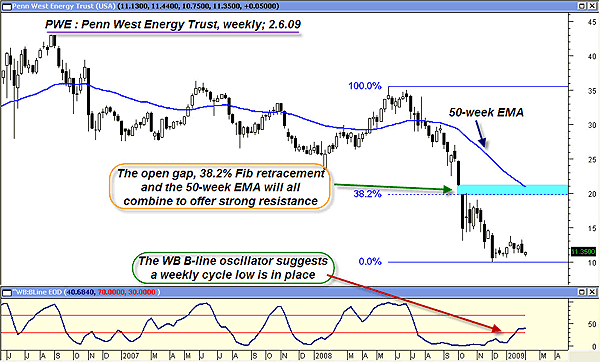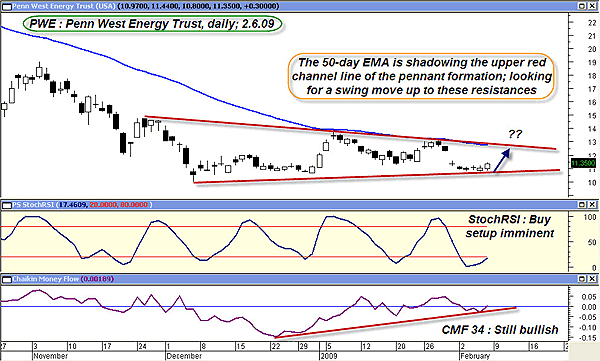
HOT TOPICS LIST
- MACD
- Fibonacci
- RSI
- Gann
- ADXR
- Stochastics
- Volume
- Triangles
- Futures
- Cycles
- Volatility
- ZIGZAG
- MESA
- Retracement
- Aroon
INDICATORS LIST
LIST OF TOPICS
PRINT THIS ARTICLE
by Donald W. Pendergast, Jr.
Canadian energy trusts took a tumble in the wake of the Canadian government's Halloween Surprise announcement in October 2006 regarding the tax treatment of these high-yielding securities. Here's a look at one energy trust that is currently setting up for a buy signal.
Position: Buy
Donald W. Pendergast, Jr.
Donald W. Pendergast is a financial markets consultant who offers specialized services to stock brokers and high net worth individuals who seek a better bottom line for their portfolios.
PRINT THIS ARTICLE
CYCLES
Two Pathways To Potential Profits For PWE
02/09/09 08:18:41 AMby Donald W. Pendergast, Jr.
Canadian energy trusts took a tumble in the wake of the Canadian government's Halloween Surprise announcement in October 2006 regarding the tax treatment of these high-yielding securities. Here's a look at one energy trust that is currently setting up for a buy signal.
Position: Buy
| Penn West Energy Trust (PWE), after being dragged down by the general decline in energy prices and the uncertainty over its tax status by the Canadian government, is now forming a major weekly cycle low (Figure 1). The WB B-line oscillator has actually crossed its buy signal line, an event that normally implies a certain amount of follow-through by the stock or commodity in question. If PWE obliges with that follow-through, significant overhead resistance lies near the $20–21 area, a price zone that includes a large open gap, a downward-sloping 50-week exponential moving average (EMA) and the 38.2% Fibonacci retracement. Without a doubt, PWE will encounter some turbulence in that price zone should this cycle move carry that far. But I have a couple of ideas on how to play PWE — one for short-term swing traders and another for longer-term players who wouldn't mind owning PWE for its towering 20.50% annual dividend (paid in 12 monthly distributions) in addition for the chance at capturing some capital gains as well. |

|
| FIGURE 1: PWE, WEEKLY. A rising weekly price cycle may offer both swing traders as well as longer-term investors the opportunity to profit from a continued move higher. |
| Graphic provided by: MetaStock. |
| Graphic provided by: WB BLine EOD from ProfitTrader for MetaStock. |
| |
| The daily chart (Figure 2) displays the rapidly approaching stochRSI buy signal, the bullish Chaikin money flow (34) trend, and the price action within the large pennant formation. Something's up here, and given the major weekly cycle low, the odds would seem to favor a bullish move — at least up to the red upper channel line of the pennant. That's the swing setup — place a buy-stop entry order at $11.46, a stop-loss near $10.75, and then hold on for an anticipated ride up toward the $12.80–13.20 area formed by the last swing high and the upper red channel line. The risk/reward ratio on this setup is very attractive, coming in at about 2.17 to 1. |

|
| FIGURE 2: PWE, DAILY. The stochRSI appears ready to cross its signal line even as the money flow trend maintains a bullish stance. Swing traders may wish to use the red upper channel line as their initial target if going long on a buy-stop entry. |
| Graphic provided by: MetaStock. |
| |
| For longer-term traders, those hungry for fat dividends, here's another twist on PWE: for every 100 shares you wish to acquire, sell one June 2009 $12.50 call option against the shares. Calls are going for about 0.65–0.70 right now (as of February 6, 2009) and can offer an additional way to generate income from this high-yielding energy trust. Here's a brief look at the outcome at June expiration: If the shares are called away (if PWE expires at $12.50 or higher), the trade will generate about $180 in gross profits. (PWE closed at 11.35 on February 6, 2009, which is the price used for the calculation.) During the duration of the trade, PWE will throw off four monthly dividends in the amount of $23 each, or an additional $92 in profits. Added to the $180 on the covered call portion of the trade, the whole shebang would yield approximately $272 on an initial cash outlay of about $1,070. That's about 25% in little more than four months, or nearly a 70% annual rate of return. If PWE fails to close at $12.50 or above at June expiration, the trader will keep all of his/her shares along with all of the dividends and option premiums. At that point, more calls can be sold if the trader believes that PWE still has more upside potential. |
| It's not often that a high-yielding stock flashes a buy signal as it attempts to rise from a major weekly cycle low. With a little research and thoughtful analysis, a bullish trader can attempt to construct various trades designed to take advantage of such a unique set of circumstances. |
Donald W. Pendergast is a financial markets consultant who offers specialized services to stock brokers and high net worth individuals who seek a better bottom line for their portfolios.
| Title: | Writer, market consultant |
| Company: | Linear Trading Systems LLC |
| Jacksonville, FL 32217 | |
| Phone # for sales: | 904-239-9564 |
| E-mail address: | lineartradingsys@gmail.com |
Traders' Resource Links | |
| Linear Trading Systems LLC has not added any product or service information to TRADERS' RESOURCE. | |
Click here for more information about our publications!
Comments
Date: 02/10/09Rank: 4Comment:

|

Request Information From Our Sponsors
- VectorVest, Inc.
- Executive Premier Workshop
- One-Day Options Course
- OptionsPro
- Retirement Income Workshop
- Sure-Fire Trading Systems (VectorVest, Inc.)
- Trading as a Business Workshop
- VectorVest 7 EOD
- VectorVest 7 RealTime/IntraDay
- VectorVest AutoTester
- VectorVest Educational Services
- VectorVest OnLine
- VectorVest Options Analyzer
- VectorVest ProGraphics v6.0
- VectorVest ProTrader 7
- VectorVest RealTime Derby Tool
- VectorVest Simulator
- VectorVest Variator
- VectorVest Watchdog
- StockCharts.com, Inc.
- Candle Patterns
- Candlestick Charting Explained
- Intermarket Technical Analysis
- John Murphy on Chart Analysis
- John Murphy's Chart Pattern Recognition
- John Murphy's Market Message
- MurphyExplainsMarketAnalysis-Intermarket Analysis
- MurphyExplainsMarketAnalysis-Visual Analysis
- StockCharts.com
- Technical Analysis of the Financial Markets
- The Visual Investor
